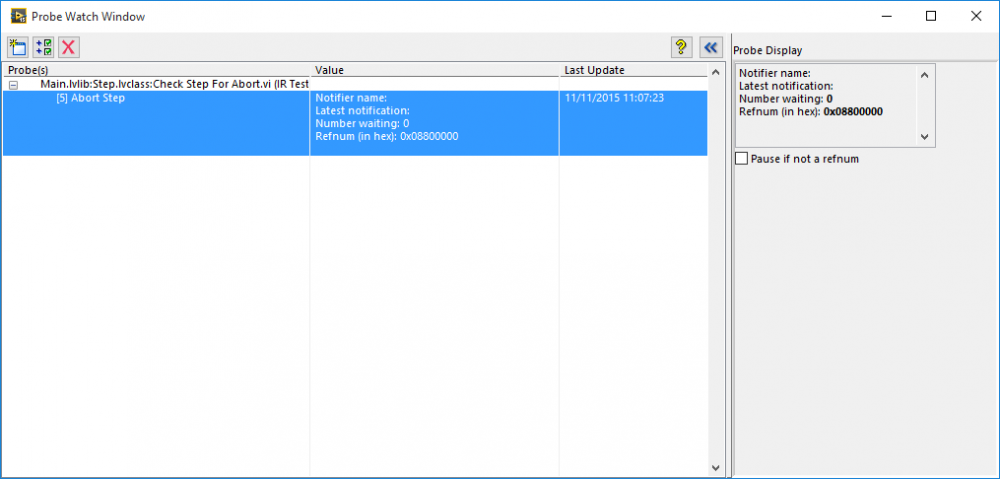-
Posts
1,198 -
Joined
-
Last visited
-
Days Won
112
Content Type
Profiles
Forums
Downloads
Gallery
Everything posted by Neil Pate
-
Hi all, I have seen something today I was not expecting. If I probe a notifier wire, in the probe window I get two different messages in the Probe Display on alternate executions of the same piece of code: I get this: Notifier name: Latest notification: Number waiting: 0 Refnum (in hex): 0x08800000 and then I get an empty value in the probe display, with the value in the table reading: "Unnamed - 0 waiting - 0x880000 So both tell me the same thing, but I wonder why I get this alternating effect. It is very noticeable in the probe window as the blue line that highlights the current probe is skinny and then fat. This is LV2015. Am I doing something strange in my code or have others seen a similar effect.
-

Subpanels: what are the rules for order of operations?
Neil Pate replied to Aristos Queue's topic in LabVIEW General
You just need to hide the fp, not close it. -

Subpanels: what are the rules for order of operations?
Neil Pate replied to Aristos Queue's topic in LabVIEW General
You certainly can run the code as you wish. A VI does not need to be running to be inserted, but if you do this and then run it there is a nasty transition when the VI changes to running. The refs are not related at all. The subpanel will not do anything with the inserted VI ref. Inserting a different VI does not destroy the original VI ref. You can get a ref to the inserted VI from the subpanel. Hold onto the VI ref if you want to do other stuff to the VI like aborting it etc -
Hi all, I remember some time ago a discussion somewhere (cannot remember where) about the possibility of a Variant To Data figuring out which data type to output depending on what type the output was wired into. Even though the type input is shown as a bold input (i.e. "required"), it is possible to leave this off. I have always manually placed down the desired output type, just as a force of habit more than anything else. It seems that as long as there are no other structures in the way the Variant To Data is able to figure out the type it is being wired into, so is there any sense in placing a type constant? Interested to hear what others do here.
-
I did not know that was possible, cool. However that sounds like a lot of work for a LabVIEW programmer
-

Problems installing DAQmx/Vision, only on Windows 10?
Neil Pate replied to Neil Pate's topic in LabVIEW General
Yeah I kinda expected it... It's a bit annoying really, it is not like Windows 10 was all of a sudden released on the world with no notice. So strangely I was poking around in my Vision pallette and even though I had to switch off my Pc during the installation the IMAQdx VIs are there. Will probably go up in smoke if I try and run them though Edit for grammar -
Hi All, I have recently cobbled together a new PC, and have put Windows 10 on it (which I really like). Everything works quite nicely, but have had a lot of trouble installing NI Drivers. I have the August 2015 Software Reference Library USB stick, and cannot install DAQmx or Vision without the installer hard-crashing my PC (power off required!). I have no issues installing other software (LabVIEW, toolkits, TestStand etc) off the USB stick. I was able to get DAQmx to install by using one I downloaded, but this technique has failed me for the Vision drivers. Anybody else experience this behaviour? I would suspect it is just something about my system the installer does not like. I have a pretty new Skylake based CPU so perhaps that could be it? Kind regards Neil
-
Right, well then I will truly park this for now. Thanks for the info Rolf.
-
Thanks guys, I did not know about the menu being non-standard. Do you think there may be some way in via the Qt DLL? Actually, there is pretty much zero % chance I am going to have time to explore that. Will just have to live with it for now.
-
Hi All, Does anybody know how to set the menubar colour in an application? I have done some digging and it seems this is possible using the windows API, just wondering if LabVIEW had some way to do this natively? (I doubt it, just thought I would ask).
-
Hi there, Has anybody used the OPC UA client that is part of the DSC toolkit? I am trying to use it to connect to a PLC and am getting error -336653 "The status of the OPC UA server is uncertain" I am able to create a local OPC UA server in LabVIEW and connect to this with no issues from the LabVIEW OPC UA client, and can connect to the PLC just fine using a different client. After speaking with NI it looks like this may be a permission issue, but I have tried all the obvious things in the OPC UA client (like client and server certificates), with the same result. Any tips? Crossposted http://forums.ni.com/t5/LabVIEW/OPC-UA-client-cannot-connect-to-PLC/td-p/3195246
-
Any suggestions for Chrome?
-
Yeah I want to try and use FTP to download things like DAQmx without having to go through the NI downloader which I find gets quite choked sometimes. Thanks for the FTP link, that will be useful for LabVIEW related stuff.
-
Hi All, I am trying to get a new PC back up to a usable state (installing software etc). Am having some trouble accessing the NI.com FTP site. Using filezilla I can access ftp.ni.com with no problems, but cannot get find support/softlib where the juicy bits get downloaded from. As I said this is a new PC so I had to create the FTP connection from memory, have I done something stupid like not put the right authentication or something?
-
I am also getting on OK with Win 10. The start menu behaviour annoyed me so I installed Start10 which makes it behave more like a hybrid of Windows 7 (which I thought worked quite well) and Win 10. You can pin as normal, I have multiple versions of LabVIEW pinned.
-

Channel Wires (Asynchronous Wires) Discussion
Neil Pate replied to AutoMeasure's topic in LabVIEW General
I agree the problem stems from calling them "wires". In LabVIEW all wires obey data-flow, period. Queues and other reference type constructs are not wires, they have a wire to represent the their reference, and that wire does obey dataflow, but the actual implementation of the queue does not live on the wire. So, I do am not really that keen on the name "Channel Wires". I would have been totally fine with just "Channels". However, I am pretty sure I will just get used to them. -
Definitely. I am speccing out a new PC and plan on having two SM951s (NVMe) into RAID0 for a theoretical read rate of nearly 4 GB/s :-) (yup thats giga-bytes per second)
-
I am thinking of putting together a benchmarking application that can be used to roughly gauge a PC/target's performance. Kind of like a FutureMark 3DMark but for LabVIEW code. Has anybody done anything like this? I know we all do lots of informal benchmarking of code to test performance of different algorithms, I am suggesting pick certain algorithms and then benchmark against different hardware/OS etc. Does anybody have any recommendations for test suites to run? I was thinking things like encryption algorithms, linear algebra, large FFTs etc, mass compile etc Would love to hear thoughts on this.
-

Any cool new features of LabVIEW or toolkit?
Neil Pate replied to doradorachan's topic in LabVIEW General
Whoooosh.... -

Old content remains in lvclass files
Neil Pate replied to Steen Schmidt's topic in Object-Oriented Programming
In the seven or so years I have been dabbling with LVOOP not once have I said, "gee I am so glad that a class maintains its mutation history". Maybe it's just the kind of applications I develop, dunno. I never serialise my classes directly to disk. Also have seen some terrible editor bugs that can be traced down to stale mutation history in a class. -
Sorry, sounds like you know more than I do about shared variables. Can you see the variables using the Distributed System Manager? Have you taken a look at Network Streams? I find them much easier to setup and debug when things don't work. Think of them as TCP/IP with all the re-connection and other management stuff taken care of.
- 7 replies
-
- compactrio
- real-time
-
(and 2 more)
Tagged with:
-
It may be down to the fact that the hostname portion of your variable URL (i.e. RT CompactRIO Target) does not make sense when running the code in the context of the cRIO. Try something along the lines of ni.var.psp://localhost/ etc etc I am not a big fan of shared variables, and try and avoid them whenever possible.
- 7 replies
-
- compactrio
- real-time
-
(and 2 more)
Tagged with:




